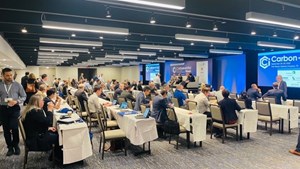Expert keynote speakers talk CCUS and tax credits at GEI’s Carbon+Intel Forum
(WO) — Global experts and professionals in the carbon capture, utilization, and storage (CCUS) space, which is experiencing rapid growth, gathered together Wednesday on day one of Gulf Energy Information’s two-day Carbon+Intel Forum in Houston. Kicking off the conference were two keynote addresses by Fred Majkut, Senior Vice President of Carbon Solutions at Schlumberger, and Jon Grimmer, President of Verde CO2.

Paradoxes and pathways. The energy transition, or industry transition, is upon us, and “we all have a responsibility around it,” Majkut said. Russia’s invasion of Ukraine and several other factors created an energy situation we’ve never faced, he added, and the past year has brought energy paradoxes that can be associated with higher carbon emissions, like an increased use of coal for power generation. “We have to balance decarbonization against the challenges associated with energy security,” Majkut said.
Realistic pathways toward net a zero pathway include several pillars, including energy efficiency, renewable energy, and CCUS, he said. The first two will each account for about 35% of the transition to net zero, while CCUS will account for about 13%, according to the presentation. While CCUS has been around for decades, the industry has never scaled up to the ambition that it can now for a number of reasons, including the lack of clear regulation and public acceptance. But that is changing, he said.
“We are seeing actually a very positive momentum, and we’re now becoming increasingly confident that the scale that never took place in the past is going to finally happen,” Majkut said. Enablers to CCUS scale-up will include technology solutions to reduce project risks and enhance economics, innovation and flexible partnership models, and versatile and cost-effective solutions across industrial sectors, his presentation showed. Collaboration and partnerships will be important at each stage along the CCUS value chain, including capture, transportation, storage and utilization. When asked about carbon capture hubs, Majkut said that it would not be possible to ramp up the scale of CCUS — from the current 30 million to 40 million tons captured annually, to gigatons captured annually — without hubs.
CCUS and tax credits. One partner that large energy companies may collaborate with is Verde CO2, which is a private, independent CCUS development company focused on decarbonizing point-sources through permanent CO2 sequestration. The company offers services like partnering directly with an emitter, who can offtake their emissions to Verde. Then, in certain situations, Verde would take care of all operations, including carbon capture, transportation, sequestration, and managing all capital and other elements of the project.
A question Grimmer often answers is how anyone makes money on a CCUS project, and there are several ways, he said. Those include the 45Q credit, which is, historically, a tax credit offered by the U.S. government, and low-carbon fuel standard credits. There also is an emerging market in the voluntary carbon offset space, Grimmer said.
Most of the major CCS legislature has happened within the past two years. In January 2021, there was treasury clarification on several CCS elements, including ownership. In November 2021, the Infrastructure Investment and Jobs Act included massive support for hydrogen, with an indirect benefit to CCS. The Inflation Reduction Act (IRA) that passed in August was “fantastic” for CCS, Grimmer said.
The IRA increased the 45Q tax credit for carbon capture from $50 per ton to $85 per ton.“Any time your revenue source increases by 70%, it’s going to change the fundamental economics of your space,” Grimmer said. Enhanced oilfield recovery (EOR) increased to $60 per ton, and direct capture increased to $150 per ton. “We were, admittedly, skeptical about direct air capture in project economics, but the IRA gave it a big shot in the arm,” Grimmer said.
Carbon+Intel Forum resumes Thursday at The Westin Galleria in Houston, Texas.


